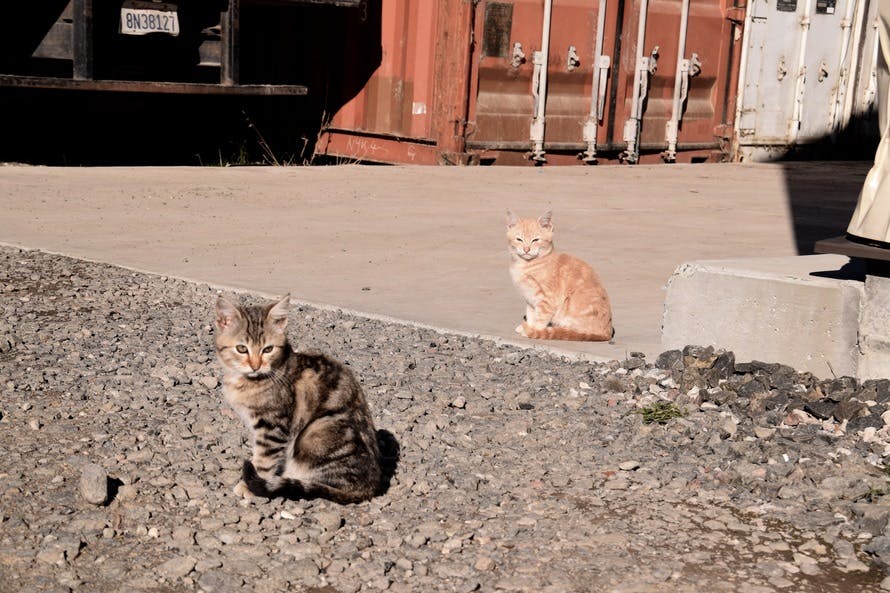This article embarks on a journey into the captivating world of feline vision, addressing the age-old question of whether cats can perceive the color red. We'll explore the intricacies of their visual system, comparing it to human vision and revealing the fascinating truths behind this enduring feline mystery.
Part 1: The Anatomy of a Cat's Eye

1.1. A Window to the World: The Structure of a Cat's Eye
Cats possess unique adaptations in their eyes that allow them to see differently from humans. These adaptations include:
- Tapetum Lucidum: This iridescent, reflective layer located behind the retina acts like a mirror, amplifying incoming light and enhancing their night vision. The tapetum lucidum is responsible for the characteristic "eye shine" you see when light reflects off a cat's eyes in the dark.
- Vertical Pupils: Unlike humans with round pupils, cats have vertical pupils that constrict and dilate to control the amount of light entering the eye. In bright light, the pupils become narrow slits, reducing glare and enhancing sharpness. In dim light, they expand to maximize light intake.
- Larger Cornea: The cornea, the clear outer layer of the eye, is larger in cats than in humans, contributing to their enhanced light gathering abilities. This allows them to see in low-light conditions with greater clarity.
1.2. The Retina: A Canvas of Light Perception
The retina, a light-sensitive layer at the back of the eye, plays a crucial role in vision. It contains specialized cells known as photoreceptor cells, responsible for converting light into electrical signals that the brain interprets as images. Cats have two types of photoreceptor cells:
- Rod Cells: These cells are highly sensitive to low levels of light, enabling cats to see in dim conditions. They are primarily responsible for detecting movement and shapes.
- Cone Cells: These cells are responsible for color perception. Cats possess two types of cone cells: blue-sensitive and green-sensitive, which allow them to perceive a range of blues, greens, and yellows.
Part 2: Decoding the Spectrum of Feline Vision

2.1. Dichromacy: The World in Two Colors
Cats, like many other mammals, possess dichromatic vision, meaning they see the world in two primary colors: blue and green. This limitation stems from the absence of a third type of cone cell, which in humans is responsible for perceiving red wavelengths.
2.2. The Missing Link: The Absence of Red-Sensitive Cone Cells
Unlike humans, cats lack the red-sensitive cone cell, which is crucial for perceiving the full spectrum of colors, including red, orange, and yellow. This deficiency means that these colors appear as variations of blue and green to a cat.
2.3. A World of Hues: The Cat's Perspective
The lack of red perception significantly alters how cats perceive the world. While they might see shades of green, yellow, and blue, their vision doesn't include the vivid reds and oranges that humans experience. Imagine a world where a ripe tomato appears as a darker shade of green or a vibrant orange sunset appears as a muted yellow.
Part 3: Living in a Dichromatic World
3.1. Navigating the Environment: The Importance of Contrast
Despite their limited color vision, cats are remarkably adept at navigating their surroundings. Their ability to perceive blues and greens allows them to effectively distinguish objects and navigate their environment, particularly in low-light conditions. The contrast between objects and their surroundings plays a crucial role in their visual perception.
3.2. The Art of the Hunt: Dichromacy and Predator-Prey Interactions
Cats' dichromatic vision is particularly advantageous for hunting. Their ability to perceive blues and greens enables them to effectively detect prey against a background of foliage, even in low-light conditions. The contrast between the prey's fur and the surrounding vegetation provides a clear visual cue for a cat's predatory instincts.
3.3. Social Signals and Communication: Beyond Color
Cats rely on a combination of visual, olfactory, and auditory cues for social communication. While their color vision might not be as nuanced as human vision, it plays a role in interpreting social signals and interacting with other cats. Body language, facial expressions, and scent play a crucial role in feline communication, often overriding any limitations imposed by their dichromatic vision.
Part 4: The Evolutionary Journey of Feline Vision
4.1. The Adaptive Advantage of Dichromacy
The evolutionary development of dichromatic vision in cats aligns with their predominantly nocturnal lifestyle. Their increased sensitivity to blue and green wavelengths provides a crucial advantage in low-light conditions, allowing them to hunt effectively during the night.
4.2. Energy Efficiency: The Trade-Off of Color Perception
Maintaining a third type of cone cell for red perception requires significant energy expenditure. For cats, the absence of red-sensitive cone cells offers an efficient solution, conserving energy while preserving their visual acuity in other critical wavelengths. This evolutionary trade-off prioritizes the needs of nocturnal hunters, optimizing their vision for survival in low-light environments.
4.3. The Symphony of Senses: Vision and Beyond
While cats have limited color vision, they possess exceptional senses of hearing, smell, and touch. This combination of sensory capabilities compensates for their color blindness, providing a comprehensive understanding of their surroundings. Their highly developed olfactory system and sensitive whiskers allow them to perceive the world in ways that humans can only dream of.
Part 5: Exploring the World Through a Feline Lens
5.1. Visualizing the Cat's World: A World of Blues and Greens
Imagining the world through a cat's eyes involves visualizing a world dominated by shades of blue and green. Reds, oranges, and yellows may appear as variations of these two primary colours, creating a distinct and captivating visual experience. Imagine a vibrant rainbow appearing as a spectrum of blues and greens, with a subtle shift in hue representing the missing red wavelengths.
5.2. The Influence of Light: The Dance of Contrast
Light and contrast play a crucial role in feline vision. The absence of red perception means that cats rely heavily on variations in brightness and color intensity to discern objects. The world appears as a canvas of light and shadow, with the contrast between objects and their surroundings playing a dominant role in their visual perception.
5.3. Beyond Color: Motion, Depth, and Agility
While color vision may be limited, cats possess excellent motion detection and depth perception. Their exceptional visual abilities enable them to navigate their environment, track prey, and interact with their surroundings with remarkable agility. This innate ability to perceive movement and depth allows them to thrive in a world where survival often hinges on split-second reactions.
Part 6: Unraveling the Mysteries: FAQs on Feline Vision
6.1. Can cats see in the dark?
While cats are renowned for their exceptional night vision, they cannot see in complete darkness. Their tapetum lucidum reflects light, enabling them to see in low-light conditions, but they still require some ambient light for visual perception.
6.2. Do cats have better vision than humans?
Cats and humans possess different visual strengths. While cats have superior night vision and motion detection, humans have better color vision and depth perception in brighter conditions.
6.3. Are cats colourblind?
Technically, cats are not completely colourblind. They can perceive blues and greens, but their vision is limited compared to humans. They lack the third type of cone cell required for perceiving red, orange, and yellow as distinct colours.
6.4. How can I tell if my cat is seeing a colour I can't?
It's impossible to know exactly what colours your cat sees. However, you can observe their reactions to different objects and colours. Their interest in certain colours or patterns might offer clues about their visual perception.
6.5. Can cats see infrared light?
While cats are sensitive to low-light conditions, they cannot see infrared light. This type of light is outside the range of their visual spectrum.
6.6. Do cats see the world in black and white?
This is a misconception. Cats see the world in two primary colours: blue and green. They do not see in black and white.
6.7. Can cats differentiate between different shades of blue and green?
While cats see a range of blue and green hues, their visual acuity in these colours is not as sharp as that of humans. They may be able to distinguish between shades of blue and green, but their perception of colour nuances is likely to be less nuanced than that of humans.
6.8. What are the implications of a cat's limited color vision for their everyday lives?
While a cat's limited color vision might not appear to be a major obstacle in their everyday lives, it does influence their interactions with their environment and their ability to perceive certain objects and colors. However, their exceptional night vision, motion detection, and other sensory abilities compensate for their color limitations, allowing them to navigate their world with remarkable success.
Everyone is watching

Are Cat Ribs Flexible? Understanding Their Anatomy
CATS & KITTENSThis article delves into the fascinating world of feline anatomy, exploring the flexibility of cat ribs and ho...

Can Cats Eat Bananas? (Everything You Need to Know)
CATS & KITTENSThis article dives into the intriguing question of whether cats can safely enjoy the sweet, yellow fruit, bana...

Cat Lifespan: How Long Do Cats Live?
CATS & KITTENSThis comprehensive guide explores the factors influencing the lifespan of our feline companions, providing ins...

Can Cats Get COVID-19? What You Need to Know
CATS & KITTENSThis article will delve into the fascinating world of feline COVID-19 susceptibility. We'll explore whether ca...

Can Cats Eat Eggs? A Complete Guide to Egg Safety for Your Feline Friend
CATS & KITTENSWhen it comes to treating our furry companions, we all want to ensure we're doing what's best for them. Eggs...
